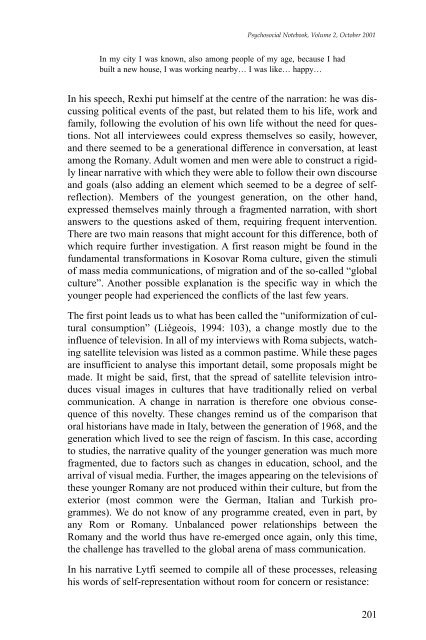Psychosocial Notebook - IOM Publications - International ...
Psychosocial Notebook - IOM Publications - International ...
Psychosocial Notebook - IOM Publications - International ...
You also want an ePaper? Increase the reach of your titles
YUMPU automatically turns print PDFs into web optimized ePapers that Google loves.
<strong>Psychosocial</strong> <strong>Notebook</strong>, Volume 2, October 2001<br />
In my city I was known, also among people of my age, because I had<br />
built a new house, I was working nearby… I was like… happy…<br />
In his speech, Rexhi put himself at the centre of the narration: he was discussing<br />
political events of the past, but related them to his life, work and<br />
family, following the evolution of his own life without the need for questions.<br />
Not all interviewees could express themselves so easily, however,<br />
and there seemed to be a generational difference in conversation, at least<br />
among the Romany. Adult women and men were able to construct a rigidly<br />
linear narrative with which they were able to follow their own discourse<br />
and goals (also adding an element which seemed to be a degree of selfreflection).<br />
Members of the youngest generation, on the other hand,<br />
expressed themselves mainly through a fragmented narration, with short<br />
answers to the questions asked of them, requiring frequent intervention.<br />
There are two main reasons that might account for this difference, both of<br />
which require further investigation. A first reason might be found in the<br />
fundamental transformations in Kosovar Roma culture, given the stimuli<br />
of mass media communications, of migration and of the so-called “global<br />
culture”. Another possible explanation is the specific way in which the<br />
younger people had experienced the conflicts of the last few years.<br />
The first point leads us to what has been called the “uniformization of cultural<br />
consumption” (Liégeois, 1994: 103), a change mostly due to the<br />
influence of television. In all of my interviews with Roma subjects, watching<br />
satellite television was listed as a common pastime. While these pages<br />
are insufficient to analyse this important detail, some proposals might be<br />
made. It might be said, first, that the spread of satellite television introduces<br />
visual images in cultures that have traditionally relied on verbal<br />
communication. A change in narration is therefore one obvious consequence<br />
of this novelty. These changes remind us of the comparison that<br />
oral historians have made in Italy, between the generation of 1968, and the<br />
generation which lived to see the reign of fascism. In this case, according<br />
to studies, the narrative quality of the younger generation was much more<br />
fragmented, due to factors such as changes in education, school, and the<br />
arrival of visual media. Further, the images appearing on the televisions of<br />
these younger Romany are not produced within their culture, but from the<br />
exterior (most common were the German, Italian and Turkish programmes).<br />
We do not know of any programme created, even in part, by<br />
any Rom or Romany. Unbalanced power relationships between the<br />
Romany and the world thus have re-emerged once again, only this time,<br />
the challenge has travelled to the global arena of mass communication.<br />
In his narrative Lytfi seemed to compile all of these processes, releasing<br />
his words of self-representation without room for concern or resistance:<br />
201

















